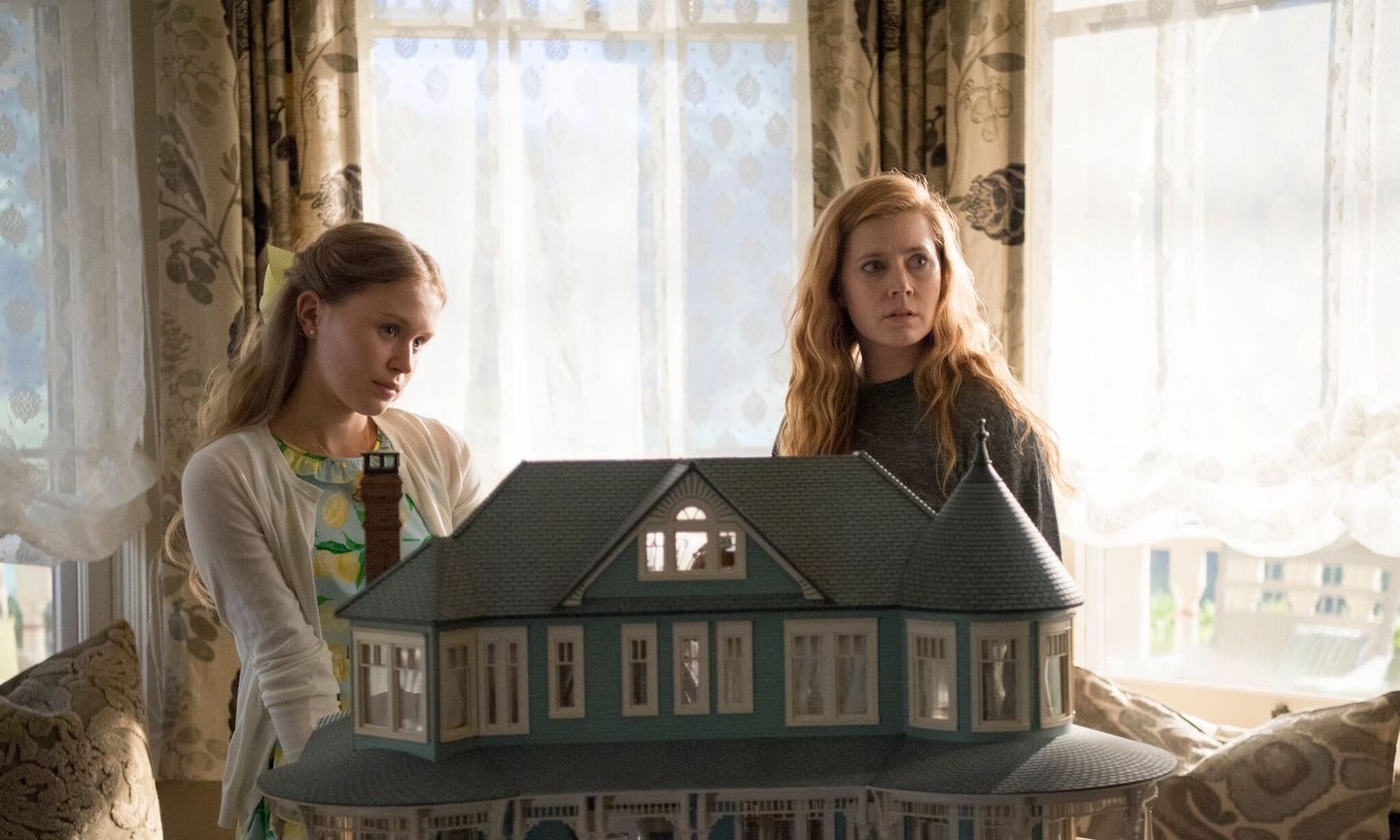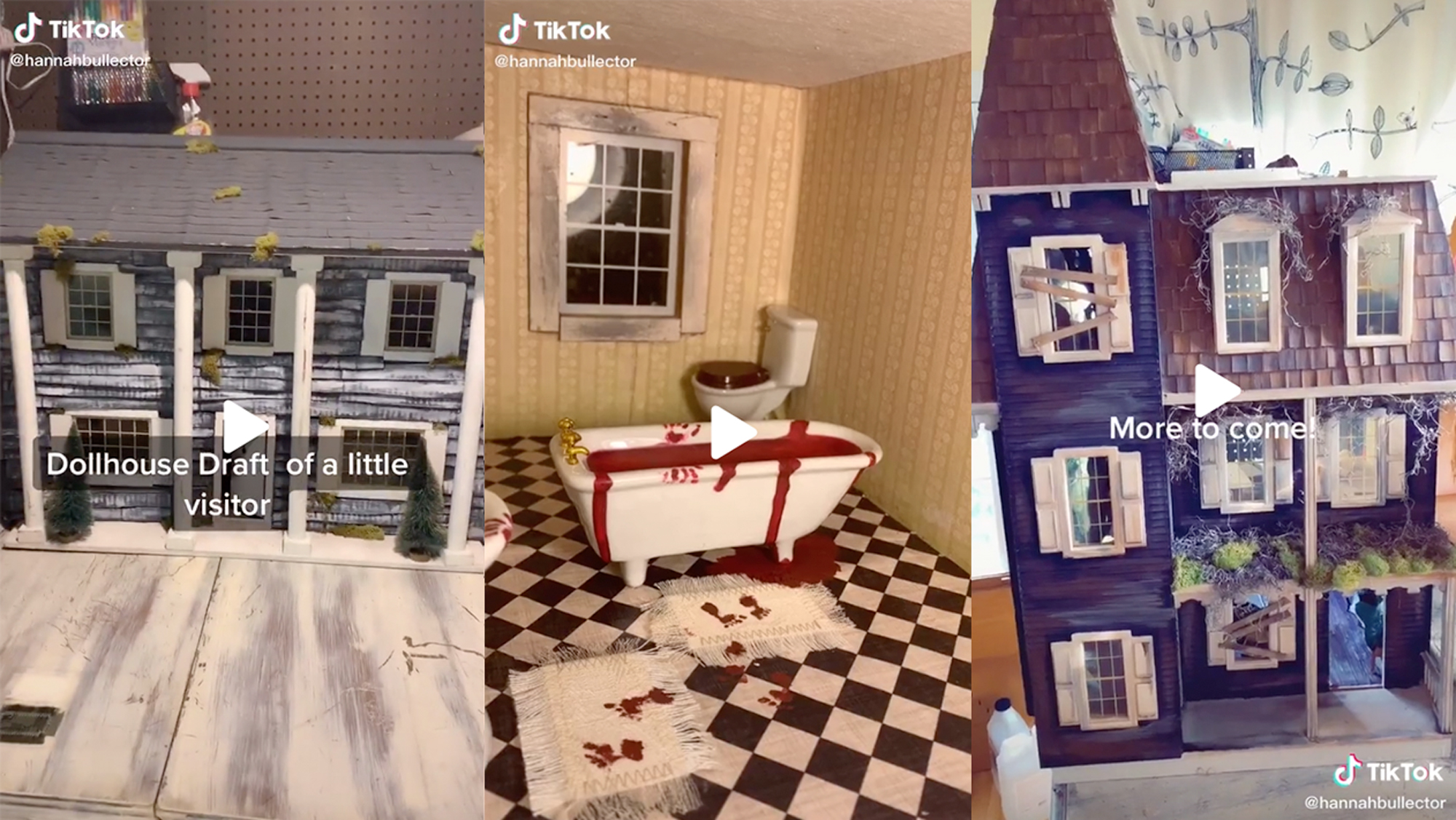Imagine a house of doors. Open one, and you’ll find a room crawling with spiders. Behind a second there are laughing clowns, and the third gives way to pockmarked, diseased walls. In the bathroom the tub is overflowing with blood, and a crimson handprint lingers on the mirror. Do you want the bad news or the good news? The bad news is that this house is very, very real. The good news is that it’s only a matter of inches tall. It can’t hurt you.
‘The Phobia House’ was created by Hannah Sellers, AKA @hannahbullector, a member of the growing community creating spooky dollhouses and sharing their tiny, terrifying creations online. She has amassed over 60k followers on TikTok, where the hashtag #haunteddollhouse has 15.8 million views.
Crafting has soared in popularity this year, with wholesome hobbies filling the gaping hours of quarantine, so it’s little wonder that miniatures, as fiddly as they are to make, are having their moment. But why haunted dollhouses, with their rickety staircases, abandoned libraries and hidden corpses?
Lauren Dodge delved into her spooky dollhouse, chronicled on her Southern Gothic Instagram account, at the beginning of the pandemic when she realised that her annual Halloween party would be cancelled. “Every year I pick a new horror theme for a big blowout Halloween, but this year that was going to be off the table,” she says. “I started thinking about making a haunted dollhouse to scratch the spook itch. If weird, cooped-up heiresses from yesteryear found solace in dollhouse making, perhaps I could too. They’re the OG quarantine queens. I had no idea people on Instagram would actually be interested in this project I made up to feel okay being locked up in a house for months.”
During this strange year, horror has bled into reality, with fear taking its place in our everyday lives. But by translating fears into something physical, creators can take control and even find some solace. These creations are a space for imaginations to run wild while most of us are confined to just a few rooms. “Creating for me is always therapeutic and the spookiness of it is part of the reward,” Hannah says. “I did really dive into it during quarantine because I actually had the time to just do something I wanted to do. Making dollhouses was almost like finding myself again through complete freedom of creativity.”
Although isolation has fuelled interest in dollhouses, they were already a reliably unsettling trope in the horror genre even before the world fell apart in March 2020. In the 2018 horror Hereditary, Tony Collette plays a miniaturist and mother, whose domestic turmoil is reflected in her work. Director Ari Aster used sets for interior shots of the family home, shooting at a distance to create the illusion of a dollhouse, compartmentalised and claustrophobic. In Netflix’s The Haunting of Bly Manor, the actions of living and dead characters are mirrored in a dollhouse, while a dollhouse floor made of teeth is a clue to the mysteries in HBO’s Sharp Objects series, based on a novel of the same name by Gillian Flynn. The latter’s most gruesome feature is something Lauren has replicated herself.

According to Sabrina Duda, psychologist and head of UX at the human experience agency VERJ, the allure of scary dollhouses is led by childhood. “Dollhouses help children to practice for real life, to make sense of the world, and also to work through their emotions,” she says. “When we combine them with spookiness the result is a dissonance between the safety, familiarity and cosiness of dollhouses, and the potential threat, the unknown and the weirdness of spooky things. We like a bit of a dissonance because it spices up our experiences.”
Ara Bentley has worked on her Addams Family inspired mini-mansion for 11 years, finally finishing it in October this year, and over 60k subscribers have watched the journey on her YouTube channel, Bentley House Minis. “I started building models in school because I was studying architecture at the time,” says Ara. “I really enjoyed picking out details and trying to duplicate them. The first project I started that was officially in the dollhouse miniatures realm was my Addams Family mansion. Being able to make things that weren’t perfect really appealed to me because if something turned out wonky or wasn’t painted perfectly I could just add some ageing effects and no one would know that it wasn’t supposed to be like that!”
The project is older than Ara’s two children, and has been a constant throughout three jobs and two homes. “It still feels a bit weird to say that it’s ‘finished’,” she says. “When you finish a painting you varnish it or frame it and it’s ‘done’ — but a project like the Addams Family mansion can be tinkered with for years. I imagine I will be adding and moving around bits for the rest of the days that I have it. My goal to ‘finish it’ was really just to get it to a point where it could be displayed and it didn’t seem like anything was necessarily missing.”
Despite being such an isolated activity, with miniaturists spending hours alone shaping their haunted houses, a strong and open community has sprung up online. Bentley House Miniatures has an entire video dedicated to making wallpaper convincingly peel off tiny walls — it has over 11,000 views. “The mini community is one of the kindest, most supportive groups I’ve ever connected with,” says Lauren. “I’ve had a conversation almost daily with somebody confessing they’ve always been interested in starting a dollhouse, but were too embarrassed to try it or don’t know where to start. That was me only a few months ago, and the folks who so kindly answered my questions and cheered me on as I fumbled through the start made it so much more fun. I’m truly grateful for them and everything I do with this account is designed to support other builders, connect them to other amazing artists and of course lift up others.”


